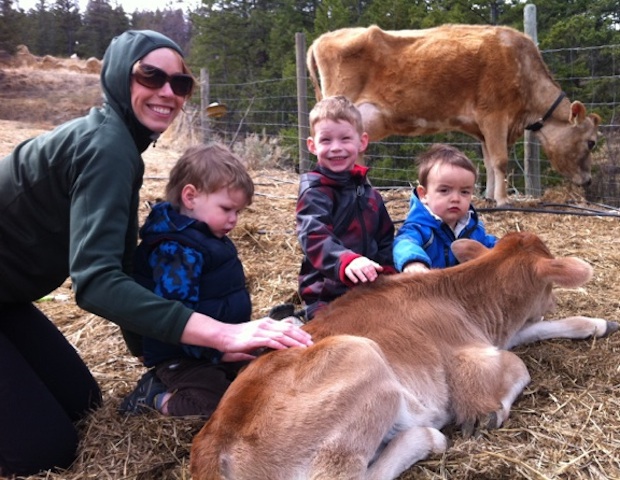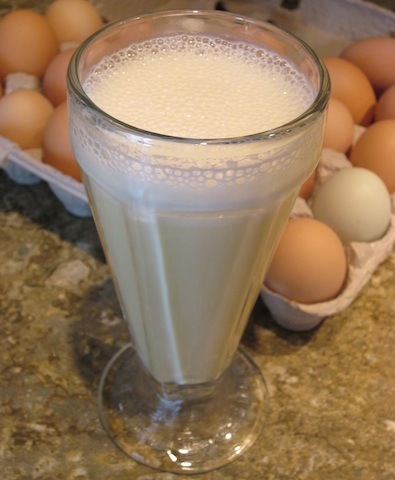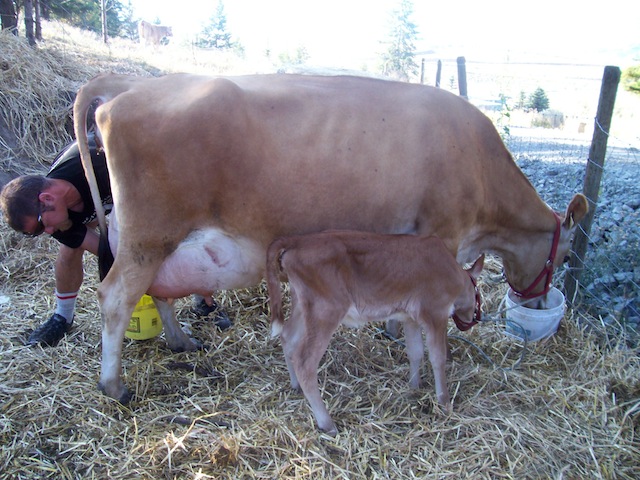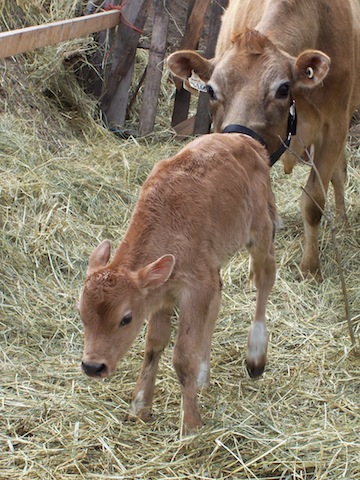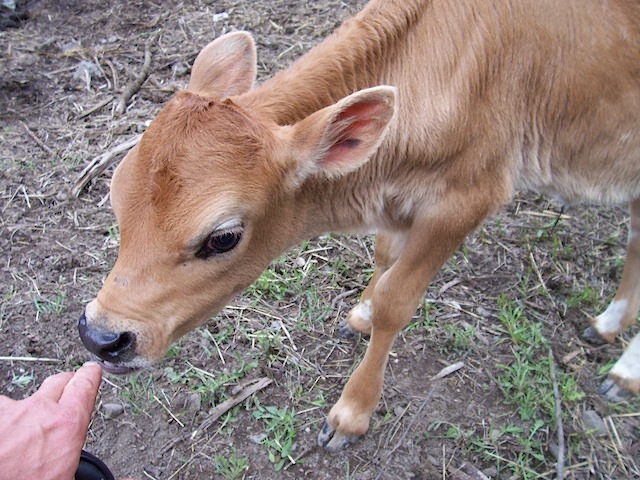
This is Cinnamon, Olivia's new calf.
On May 3, 2011 Olivia gave birth to a heifer we have named Cinnamon. It is hard to believe it has been just over seven weeks since her birth. In the last update, we were worried that Cinnamon would develop scour, but thankfully this did not occur. We have left Olivia and Cinnamon together. This is not standard dairy procedure. Dairies normally separate the cow and calf at birth. This allows the dairy to control the cow calf relationship and the calf’s food intake. The calf is fed colostrum for the first few days of life. Without enough colostrum the calf will pick up an infection and die. Later, the diary switches over to cow’s milk, or more commonly, a milk substitute. A milk substitute is used because it is cheaper.
Leaving the calf with the cow is a controversial management style. We think it is better for the calf to have an unrestricted feeding schedule. The cow and calf work out a natural feeding cycle. The calf never gets too hungry, having unlimited access to her mother, thus conditions like scour are unlikely to occur. We think Olivia is happier too. I can’t say I know what Olivia is thinking or feeling but she seems like a content cow to me. Some people believe by leaving the nursing pair together the cow will teach the calf how to be part of the herd.
We had some problems when we first started milking Olivia. She had come from a commercial dairy and had never been hand-milked before. She was used to machines touching her, not people’s hands. We had to work on making our touch a pleasurable experience. Shaen and I have found sharing the milking chore made it easier and fun. Since few modern people have ever milked, or even seen a milking, I thought I would describe a typical milking. Of course, things don’t always go smoothly. One thing cows like is routine. When the routine goes wrong the milking can go wrong too. (If any readers of this blog would like to learn how to milk please contact us and we will make arrangements. Milking is an experiential activity.)
Before milking, we get our equipment together. In one pail, I keep 15′ rope with a carabiner on one end, two brushes, a roll of paper towels, and a jar of coconut oil. In a second pail I have clean water for washing. My third pail has the milking treats. When we are ready to milk, we tie up Olivia and give her a treat of soaked grains or peas, haylage, or green forage. I give her a brush to clean off any loose hair and dirt, while Shaen washes her udders with water and dries her off with paper towels. We use coconut oil for its anti-microbial properties and as a milking lubricant. During milking, if I find my hands getting dry, I squirt some milk and rub my hands together. Milk is a great lubricant too. When we are ready to milk, Shaen works on one side and I the other, with the pail between us. Shaen’s job is to pull the pail if Olivia starts moving around. It’s really important to agree on who is going to put the pail! We milk in a full squatting position which is easier on our backs than kneeling or a milking stool. We may be milking anywhere in the pasture so having a “mobile chair” is very convenient. A full squat is very comfortable for milking but it does take time for a modern person to find the position comfortable.
Olivia is averaging 80L of milk per week, plus feeding her calf. When a cow first starts producing milk, the percentage of cream is low. As the calf grows and needs more nourishment, the cream content increases. We are presently freezing extra milk and making yoghurt and raw cheese. Soon we will be making ice cream and raw butter. Buttermilk, the byproduct of butter making, will be going to our four hogs. We use the buttermilk instead of water to soak the grains and peas. The hogs love it!
Olivia has had her first estrous cycle. Last year we got twin male and female calves from Gort’s Gouda Cheese Farm for Patty after Patty lost her calf. In cows, when male and female calves share a uterus, the male is usually fertile and the female is sterile. The female is called a freemartin and will develop more like a steer. We did not castrate the male and he appears to be a fully functioning bull. The bull has shown interest in Olivia. In a few days we will know if she has conceived or not.
Some people might be worried about us having a dairy bull. Dairy bulls are known for their aggression. When we were at Wildfire Jersey, Christine Blake was in the pen with their pure-breed Jersey bull. She had her back to him. I was worried about her safety and she explained that they keep their Jersey bulls for two years. Her experience is that young bulls are not very dangerous. After two years of age the bulls become very aggressive. Since we have bottle fed our bull as a calf, we can handle him safely, but we know the time we can manage him is limited. We intend to use him this year to breed Olivia and his foster mother, Patty. After his task is completed he will go to slaughter.
